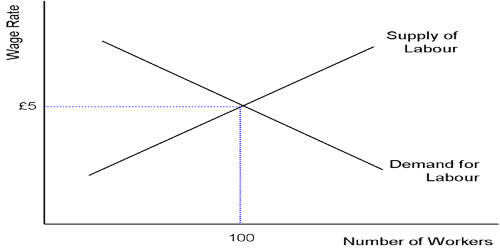Labor market flexibility is an important part of the labor market. The degree of labor market flexibility is the speed with which labor markets adapt to fluctuations and changes in society, the economy, or production. It is an important aspect of how labor markets function to adjust supply to demand. The most common definition of labor market flexibility has been the neo-liberal definition. It allows companies to make certain decisions about changing their labor force as a response to fluctuations in the market and to help boost production. This entailed the ease of labor market institutions in enabling labor markets to reach a continuous equilibrium determined by the intersection of the demand and supply curves. It is central to the supply-side of the macro-economy, and to its overall performance in achieving macro-economic objectives.
Theory
Labor market flexibility allows companies to make decisions about their labor force in response to market changes and to help boost production. The most well-known concept of labor market flexibility is given by Atkinson. Based on the strategies companies use, he notes that there can be four types of flexibility.
- External numerical flexibility
External numerical flexibility is the adjustment of the labor intake or the number of workers from the external market. It is seen as a way to reduce unemployment, increase efficiency, and encourage entrepreneurs to take a risk and employ workers. This can be achieved by employing workers on temporary work or fixed-term contracts or through relaxed hiring and firing regulations or in other words relaxation of employment protection legislation, where employers can hire and fire permanent employees according to the firms’ needs.
- Internal numerical flexibility
Internal numerical flexibility, sometimes known as working time flexibility or temporal flexibility, is achieved by adjusting working hours or schedules of workers already employed within the firm. If we take cutting unemployment benefits. The idea is that this provides an incentive to look for work and accept lower-paying jobs. This includes part-time, flexi-time or flexible working hours or shifts (including night shifts and weekend shifts), working time accounts, leaves such as parental leave, and overtime.
- Functional flexibility
Functional flexibility or organizational flexibility is the extent to which employees can be transferred to different activities and tasks within the firm. Making it easier to hire and fire workers reduces the cost of taking new workers, but it may lead to more temporary employment. It has to do with the organization of operation or management and training workers. This can also be achieved by outsourcing activities. Job rotation is a label given to many functional flexibility schemes.
- Financial or wage flexibility
Financial or wage flexibility occurs when wage levels are not decided collectively and there are more differences between the wages of workers. It is the degree to which a company is able to modify its labor force to maximize productivity. This is done so that pay and other employment costs reflect the supply and demand for labor. This can be achieved by rate-for-the-job systems, or assessment based pay system, or individual performance wages.
















